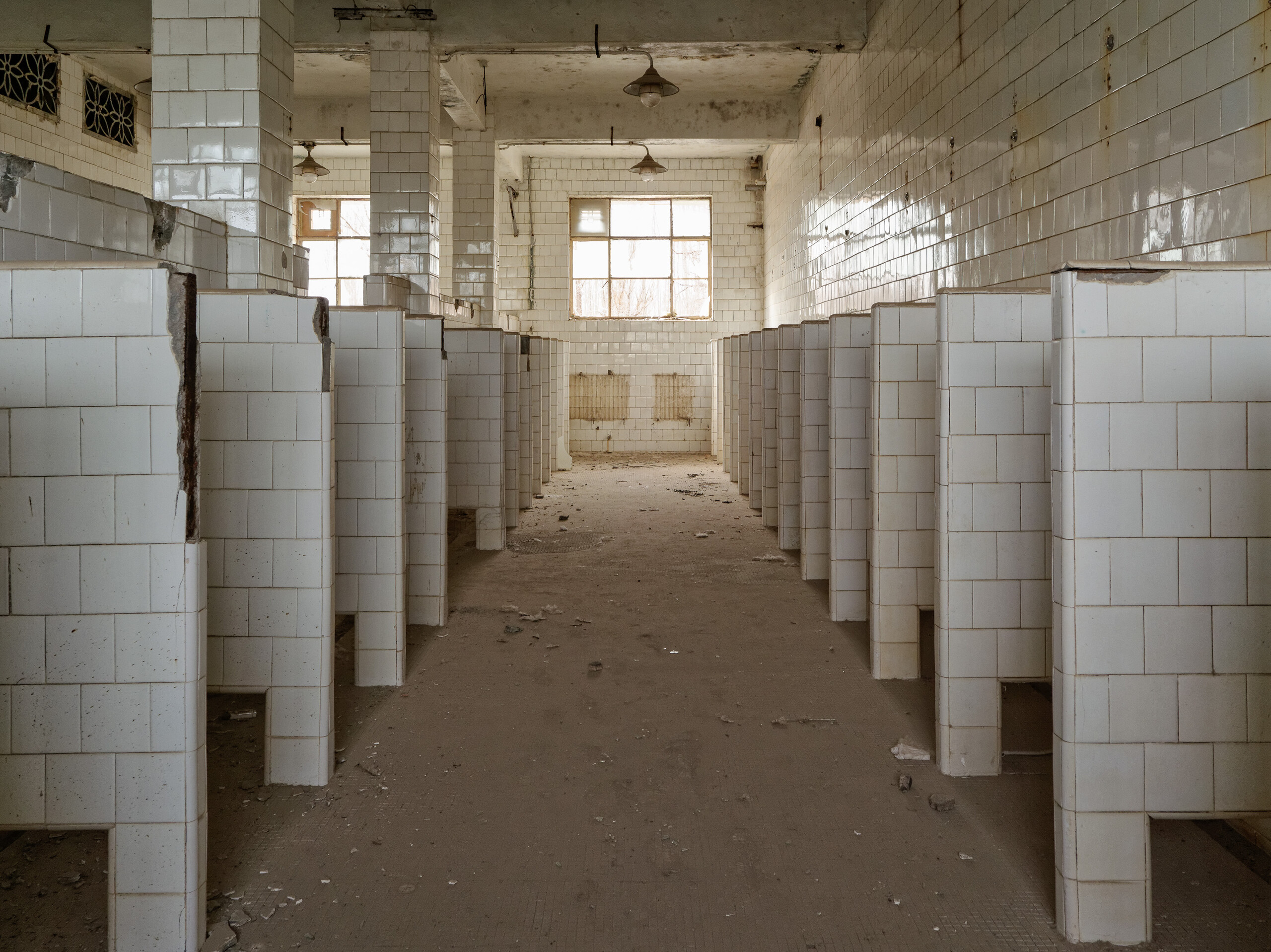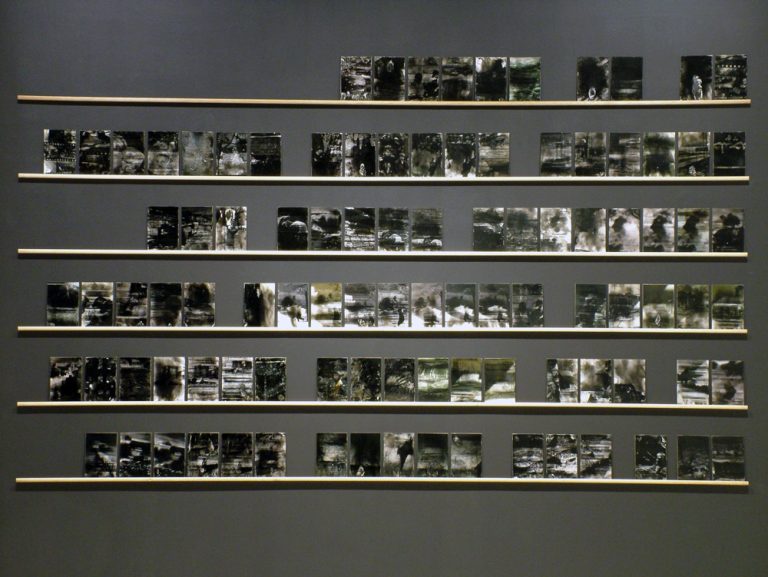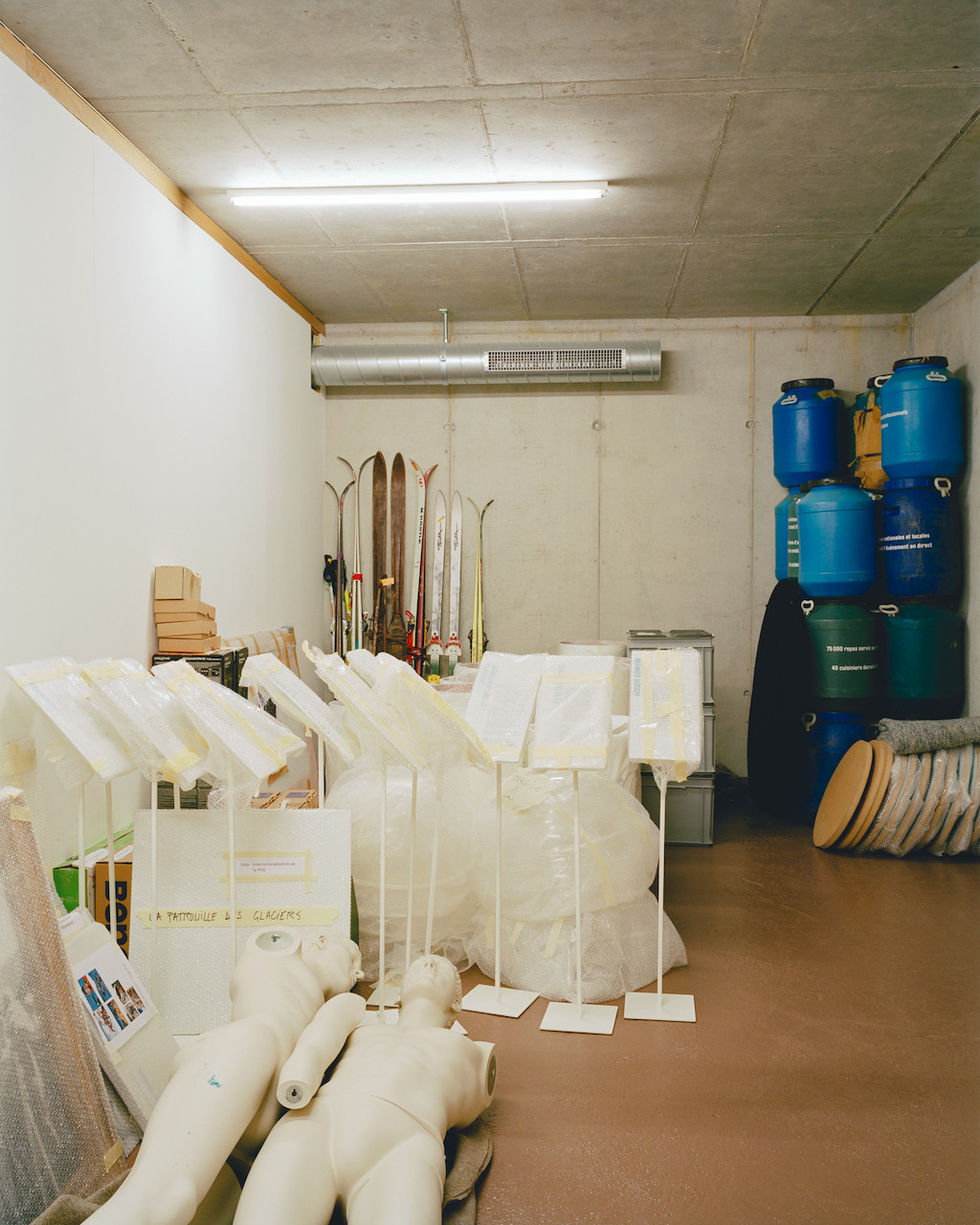Walking Through the Darkness
Diego Ramírez
Walking Through the Darkness at Centre for Contemporary Photography is a large exhibition with fifteen artists that looks at the role of darkness in the photographic medium. Referred to as the gallery’s “winter exhibition” and without visible curatorial credits, one first assumes that it was curated in-house. Although one may discover later that the press release includes a quote by Catlin Langford, who is referred to as the curator, yet not clearly identified as such for this exhibition (life’s a mystery). Under the premise of the camera as a witness, it brings together local and international artists working with suburbia, war, interpersonal trauma, and the non-human to encompass everything that is dark.
As an embarrassed member of the sadder than sad “Pirates of the Caribbean crowd,” as Lisa Radford would say, I’m perhaps the target audience for Walking Through the Darkness. Indeed, the exhibition unfolds against the backdrop of a renewed interest in an aesthetic of darkness, with various galleries staging exhibitions that explore these semantics, such as Verge Gallery’s Horror is Nothing Other Than Reality and ACCA’s upcoming From The Other Side, in response to a wider preoccupation with this theme in a culture riddled with anxiety (a “resurgence” of the cinematic genre of horror, as the press has called it since 2017). However, I find myself struggling to connect with this exhibition in a meaningful way; I have the common experience of feeling great respect for the artists’ individual practices (many touching on important, pressing, and sensitive subjects) but suspicion for the infrastructure that facilitates their showing. From the desire to fold disparate works into a single very general curatorial premise, to CCP’s oddly corporate looking premises (my urge to stain their walls is strong), the show’s framework is not promising.

Indeed, it is an uncomfortable feeling that emanates from the Sean Godsell Architect’s white walls, shmick paper, and managerial cleanliness. Tsk—a part of me feels guilty writing these unkind thoughts about the gallery (as if keeping an arts organisation alive wasn’t hard enough). But this is the reality of what I am looking at: images of bad things happening to other people, viewed from a cushy vantage point. While this is an inevitable aspect of the media gaze, the corporate aura of CCP brings this to the fore in an excruciating manner. Wandering through the show is a dark experience indeed. Why would a space like this commerce in darkness with such heaviness, soliciting politically charged and solemn work from artists with intense lived experiences, without proper elaboration?
The show ultimately neglects to tease out a robust dialogue for this complex content. The outcome is a sense of superficiality that aesthetises darkness for public display, creating an uncomfortable environment to encounter the individual works. It makes me wonder how public galleries consider their premises, atmosphere, and symbolic value in the process of platforming art. Or not. This is not a moral judgement, or a post-The White Pube antic designed to bring me closer to the institutional object of my criticism (where an individual gets super righteous under the guise of social justice to activate taming devices within the institution that grants them support, by way of damage control, in a covert quest for power). It is instead an observation about how the exhibition’s institutional framing fails to give justice to the individual works or their relations to one another. The issue is that Walking Through the Darkness shapes and guides spectatorship in ways that are kinda strange, as its presentation and conceptualisation produces a simplistic encounter from one image to the next. This undermines the works and becomes a vibe kill for the viewer.

This is evidenced in the first work we encounter in the gallery: Todd Hiddo’s pictures of suburban houses (one of the hero images on the CCP’s website). These big and glossy prints—hung on a large wall painted black—inevitably function as the entry point for the incredibly harrowing stories that haunt subsequent works. Yet, while Hiddo’s David Lynchian aesthetic has its own richness—see Mark Fisher’s The Weird and the Eerie, 2018—his photographs in this context are a jarring introduction to many of the exhibition’s other works, which deal with darkness in the form of intensely difficult and complex life experiences. Like, not all categories of darkness are quiiiite the same. This isn’t an indictment of blasé gothic-ish artists (ahem), but rather an example of how spaces often neglect to build an appropriate dialogue for the works they show.
More strangely, it strikes me as a form of self-sabotage, since a conceptual scaffold and real estate to show (plus development support) can be some of the most important contributions a gallery makes to an artist. These elements are expected to elevate the works on display to collectively benefit the gallery, the artists, and the public. In Walking Through the Darkness, however, the gallery seems to be possessed by its own theme, allowing us to witness its own mechanisms turning darkly against itself. It is the conceptual and architectural space of the white cube that forecloses any complex engagement with the dark.

Negging aside, art reigns supreme in this exhibition, as many striking works overcome the institutional limitations. One of them is Rushdi Anwar’s A Few Lines of History (2011), comprised of small prints treated with smoke and mounted on wooden board, arranged in lines to resemble sentences. According to the exhibition text, these panels depict people, places, and interiors linked to:
the 1988 chemical attack on Anwar’s childhood home city Halabja. Among the approximately 15,000 people killed or injured were members of Anwar’s family. This attack, now known as the Halabja massacre, was part of the Anfal campaign by the Iraqui Sadam Hussein regime that aimed to eliminate Kurdish people.
As an installation, Anwar’s prints are neatly ordered, in high tension with the political chaos of their content. Their surfaces—blurred, distorted, and consumed with smoke—resemble the murky imaginings of memory, where the image becomes distorted with each new recall.
While there is a high journalistic value to the artist’s endeavour, by bringing an underreported attack to the fore, the works remain decisively lyrical. For instance, Anwar deploys the poetic device of repetition across his pictorial lines to startling effect. This means that many of his images sit next or near to imperfect copies of themselves, as the smoke treatment creates noticeable differences between them (sometimes blackening the totality of the photograph). This applies to various panels showing troublesome scenes, including but not limited to people yelling, smoke explosions, the backs of children, and bodies lying on the ground. This mechanism serves the purpose of activating a realm beyond reason, as our gaze moves through these phantasmagorical depictions to stumble upon enigmatic instances that challenge a conclusive meaning but tease us with the promise of a resolution. The same can be said for the empty spaces that break the panel lines, for they engulf our eyes with a sinister absence. While the visible horrors of this attack are certainly disturbing, the unseen terrors of blankness evoke similar anguish, by implying the unrepresentability of that which remains unshown. As the exhibition text suggests, we are also tempted to create a narrative from this arrangement, an urge to decipher a story that is often complicated by the unclear sequence that binds the people, places, and events on view.

Next to Anwar, we find Darren Tanny Tan’s Lingchi #3–4, a triptych of archival prints referencing lingchi, “an extreme form of capital punishment” found in China until the early twentieth century (otherwise known as “death by a thousand cuts”). In these large-scale works, a series of scratches cover barely discernible images, graded with a nostalgic sepia tone. As one inspects the pictures closely, hellish fragments of punishment become visible. Tan made these works by appropriating images of lingchi that circulated in the West during the early twentieth century, when it was common to find morbid ethnographic scenes of death and punishment in mass media, such as postcards. Even though the circulation of such images is today no longer so welcomed—as we become increasingly attuned to the ongoing disenfranchisement of these people’s identity and their kin—artists like Ken Gonzales-Day, who works with early twentieth century images of lynched Mexicans in the USA, frequently engage with this strange period in visual culture as source material for artworks dealing with the Western gaze. Tan’s triptych blurs, peels off, and scratches most of the image to soften this problematic, which also serves the purpose of making the image more appropriate for the contemporary viewer.
While the act of scratching the photograph intentionally mimics this form of capital punishment, it also inevitably evokes more immediate forms of cutting. The act of self-harm comes to mind, figured here as the artist deteriorating their own work. Rather than approaching the work through the lens of interior psychological states, however, we must remember that Tan is working with material that once held the currency of mass culture. One can thus draw a line to sensibilities of dark media in contemporary popular culture, for turning damage to oneself signals an abundance, the belief that there’s an endless body to wreck: more skin to mark, more pain to release.
As the editor of this Memo, Nick Croggon, points out (in a gentle and intelligent replacement of my original yet disorienting reference to the manga/anime Death Note), this mimics the “disposability and excess” of mass culture. Croggon makes an excellent point on this work’s relationship with George Bataille’s theory of excess and his own use of images of linghci (you’re welcome for this exclusive ‘behind the scenes’). But I’m just thinking about self-injuring emos. More specifically, the way their bodies become a mediator of media by adopting a commercial image to the point of self-injury, until they meet the limitations of their mortality—exceeded by the infinite supply of mass media, where the perfect yet unreal emo is able to withstand damage for eternity. Of course, the human vessel of the everyday subject is unable to support this ideal and surrenders to reality with increased pain. In this way, Lingchi #3–4 appears to charge the diaspora trope of sampling early twentieth-century ethnography with a violent impetus that evokes art historical and pop-cultural associations alike. As someone inclined to indulge in downer media, I found the effect “pretty sikk.”

Near these works and in the middle of CCP’s back gallery is Liss Fenwick’s Mastotermes, a video with sound by James Paul recording giant termites eating books. Fenwick explains that they have been fostering this termite colony “on the rural block where they grew up” in so-called northern Australia. For this work, they fed this endemic species books in English and recorded them from “within their deep underground nests.” Clearly positioning theirself as an English-speaking settler who speaks English on the land of the Larrakia language group, Fenwick frames their language as an invasive entity. Croggon points out in another well-deserved editing cameo, that the books are “consumed and excreted” like “fuel,” so one could say that this simile also speaks to a kind of systemic transformation of language. Of course, the sight of a native species feasting and shitting imperial matter conjures a carnivalesque notion of change. This idea starts to approximate virtue signalling and gets tricky, when one considers English devastated First Nations languages, and it’s a video made by a speaker of the former, but I would say the work itself focuses on a gothic rural sensibility while acknowledging its positionality. Once again, this is a delicate point that requires a more vigorous and considerate context than what the show’s theme is able to offer or sustain. I also found it weird that the didactic failed to mention that the books belonged to the artist’s father, and were part of a collection reflecting his idea of progress in rural Queensland (which sounds like the real content of the work).
As the giant termites feast on the artist’s father’s objects of knowledge, our gaze tries to rescue words from dissipation. While full pages are difficult to grasp—inverted upside down or simply devoured beyond recognition—fragments remain discernible. This is especially true of what appears to be an encyclopaedia, notably holding the word “doubtful.” I am embarrassed to confess that I have an emotional reaction at the sight of vanishing books, especially considering the colonial status of the English language—making this a reminder that at least 250 First Nations languages were lost to invasion. High resolution and the macro lens also afford this footage an aesthetic that is difficult to define. But my best shot is a Jorge Luis Borges’s daydream: the kind of thing he would indulge in a library-esque, hyperreal, and cryptic reverie, during a trivial conversation.

The brevity of this review does not allow me to touch on the rest of the show, which includes a large cohort of artists, such as Seiichi Furuya, Buzz Gardiner, Amos Gebhardt, Ori Gersht, Rinko Kawauchi, Li Yang, Morganna Magee, Georgia Metaxas, and Vanessa Winship. But I was enchanted by Chloe Dewe Matthews’s In Search of Frankenstein, a suit of c-type prints and canvas wallpapers inspired by Mary Shelley. The project combines Frankenstein’s handwritten manuscript (blown up on the wall) with images of the alpine landscape that presumably inspired Shelley. These are snowy and sublime scenes mixed with shots of a subterranean bunker network that inhabit the area, built in 1960 to “house the entire population of Switzerland in the event of a nuclear disaster.” It looks like the mood board for a Netflix series where everyone gets murdered.
The idea of self-sabotage lingers on my mind, as I wonder if the white cube itself is a nightmarish, living entity seeking its own destruction. Perhaps the role of concepts is to modulate this inevitable death drive, and curatorship is a soothing mechanism. Or is it the living dead prolonging its inevitable end?
Diego Ramírez is an artist with dreams, a writer with hopes, and a facilitator with beliefs. He has written locally for Art Gallery of Western Australia, Art and Australia, Disclaimer, MEMO, un Projects and internationally with NECSUS (NL) and BLUE journal (US x FR). He is represented by MARS Gallery.


